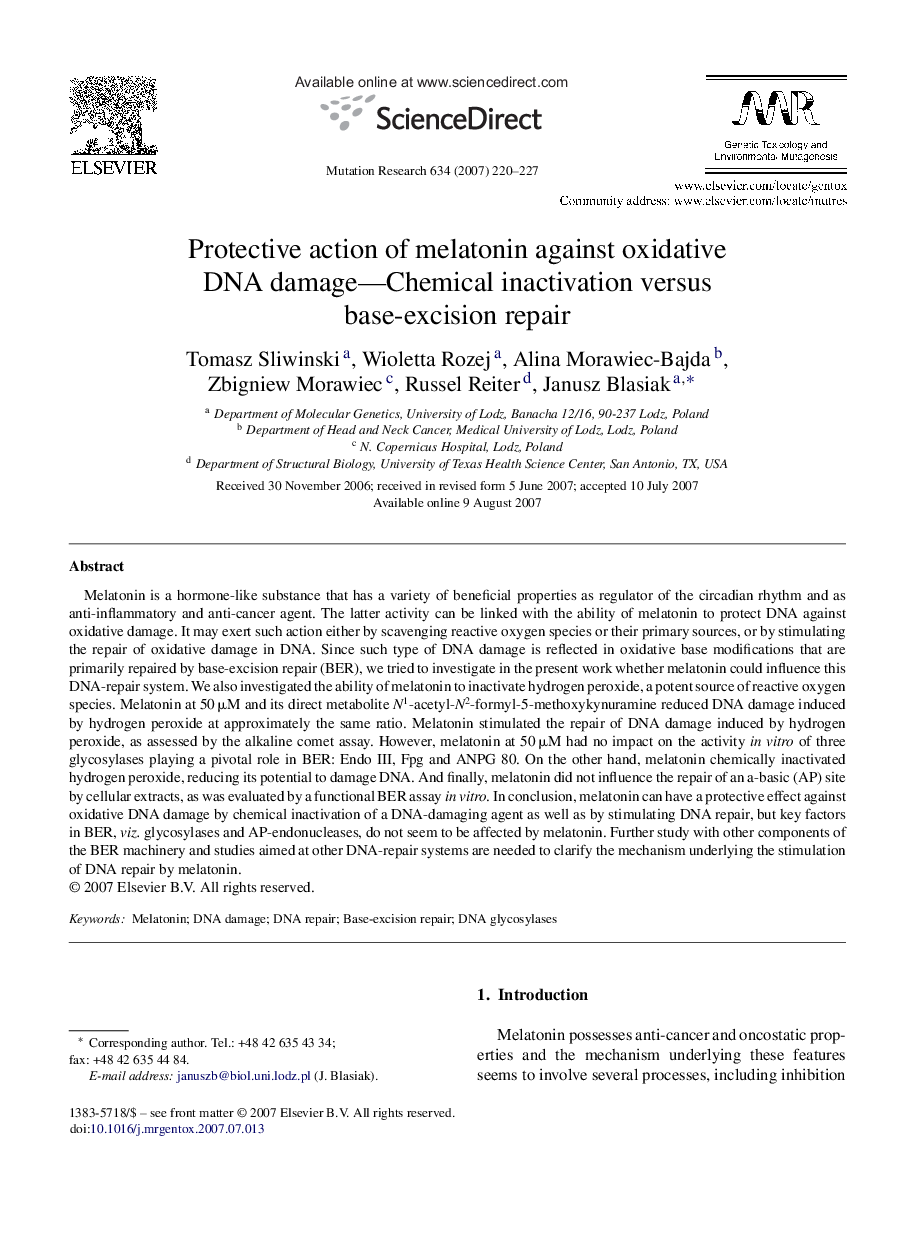| کد مقاله | کد نشریه | سال انتشار | مقاله انگلیسی | نسخه تمام متن |
|---|---|---|---|---|
| 2149065 | 1548638 | 2007 | 8 صفحه PDF | دانلود رایگان |
عنوان انگلیسی مقاله ISI
Protective action of melatonin against oxidative DNA damage-Chemical inactivation versus base-excision repair
دانلود مقاله + سفارش ترجمه
دانلود مقاله ISI انگلیسی
رایگان برای ایرانیان
کلمات کلیدی
موضوعات مرتبط
علوم زیستی و بیوفناوری
بیوشیمی، ژنتیک و زیست شناسی مولکولی
تحقیقات سرطان
پیش نمایش صفحه اول مقاله

چکیده انگلیسی
Melatonin is a hormone-like substance that has a variety of beneficial properties as regulator of the circadian rhythm and as anti-inflammatory and anti-cancer agent. The latter activity can be linked with the ability of melatonin to protect DNA against oxidative damage. It may exert such action either by scavenging reactive oxygen species or their primary sources, or by stimulating the repair of oxidative damage in DNA. Since such type of DNA damage is reflected in oxidative base modifications that are primarily repaired by base-excision repair (BER), we tried to investigate in the present work whether melatonin could influence this DNA-repair system. We also investigated the ability of melatonin to inactivate hydrogen peroxide, a potent source of reactive oxygen species. Melatonin at 50 μM and its direct metabolite N1-acetyl-N2-formyl-5-methoxykynuramine reduced DNA damage induced by hydrogen peroxide at approximately the same ratio. Melatonin stimulated the repair of DNA damage induced by hydrogen peroxide, as assessed by the alkaline comet assay. However, melatonin at 50 μM had no impact on the activity in vitro of three glycosylases playing a pivotal role in BER: Endo III, Fpg and ANPG 80. On the other hand, melatonin chemically inactivated hydrogen peroxide, reducing its potential to damage DNA. And finally, melatonin did not influence the repair of an a-basic (AP) site by cellular extracts, as was evaluated by a functional BER assay in vitro. In conclusion, melatonin can have a protective effect against oxidative DNA damage by chemical inactivation of a DNA-damaging agent as well as by stimulating DNA repair, but key factors in BER, viz. glycosylases and AP-endonucleases, do not seem to be affected by melatonin. Further study with other components of the BER machinery and studies aimed at other DNA-repair systems are needed to clarify the mechanism underlying the stimulation of DNA repair by melatonin.
ناشر
Database: Elsevier - ScienceDirect (ساینس دایرکت)
Journal: Mutation Research/Genetic Toxicology and Environmental Mutagenesis - Volume 634, Issues 1â2, 1 December 2007, Pages 220-227
Journal: Mutation Research/Genetic Toxicology and Environmental Mutagenesis - Volume 634, Issues 1â2, 1 December 2007, Pages 220-227
نویسندگان
Tomasz Sliwinski, Wioletta Rozej, Alina Morawiec-Bajda, Zbigniew Morawiec, Russel Reiter, Janusz Blasiak,